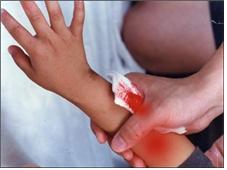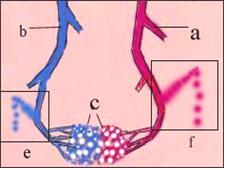급성 출혈성 빈혈 Anemia caused by acute bleeding
급성 출혈성 빈혈의 원인
-
출혈이 몸속의 신체의 한 부위에서 몸속 다른 부위로 출현하면 내출혈이라 하고 몸속에서 몸 밖으로 출혈하면 외출혈이라 한다.
-
급성으로 출혈되면 급성 출혈성 빈혈이 생길 수 있다.
-
내·외 외상 등으로 내출혈이나 외출혈이 갑자기 생길 때
-
혈액응고 인자 감소로 내출혈이나 외출혈이 갑자기 생길 때
-
소화성 위궤양이나 그 외 위장관 병으로 위장관 출혈이 갑자기 생길 때
-
폐나 그 외 호흡기계 질환으로 출혈이 생길 때
-
두개강 내, 흉강 내, 또는 복강 내 출혈이 갑자기 생길 때
-
신생아의 탯줄에서 출혈이 생길 수 있고,
-
신생아가 피를 토할 때
-
허벅다리 뼈 골절,
-
허벅다리 총상으로 허벅다리의 큰 동맥이 잘릴 때,
-
높은 곳에서 떨어지거나 둔기 등으로 복부에 타박상을 심하게 입을 때
-
간장, 비장, 또는 신장 등 복강 내 장기가 파열 될 때
-
그 외 급성 내출혈로 급성 출혈성 빈혈이 생길 수 있다.
급성 출혈성 빈혈의 증상 징후
-
급성으로 흘린 피의 양과 출혈을 일으킨 원인에 따라 증상 징후가 다르다.
-
인체의 총 혈량의 15~20%를 짧은 시간 내 갑자기 출혈로 잃으면 맥박이 빨라지고 안절부절 못하고 혈압이 갑자기 떨어진다. 대부분의 경우 쇼크에 빠질 수 있다.
-
신생아들의 혈 량은 체중 매 kg 당 75~85cc 정도이고,
-
신생아기 이후 영유아들의 혈 량은 체중 매 kg당 65~75cc 정도이다.
-
신생아들이나 영유아들에게 생긴 출혈의 양이 소량인 것 같지만 영유아기 이후 학령기 아이들이나 사춘기 아이들 또는 성인들이 흘린 피의 양에 비하면 아주 많은 혈 양에 해당 될 수 있다.
급성 출혈성 빈혈의 진단
-
병력, 증상 징후와 진찰소견 등을 종합해 내출혈이나 외출혈을 진단한다.
-
CBC 피 검사를 하여 내출혈이나 외출혈의 정도를 알아본다.
-
신체의 한 부위에서 바로 그 주위에 있는 신체의 다른 부위 속으로 출혈 되든지,
-
또는 신체의 어느 부위에서 출혈되는지 알아보기 위해 위액, 대변, 소변 등 피 검물로 피가 나 고 있는지 검사할 수 있다.
-
피가 신체의 한 부위 속에서 신체 밖으로 나오는 출혈은 눈으로 보고 어디서 외출혈이 나는지 쉽게 진단하고 적절히 속히 치료 할 수 있다.
-
그렇지만 복강 내, 흉강 내, 두개강 내 또는 그 외 신체의 한부위 속에서 그 신체 부위의 바로 다른 부위 속으로 나는 출혈은 눈으로 직접 볼 수 없다.
-
내출혈의 원인과 내출혈이 생긴 신체 부위에 따라 증상 징후가 다르게 나타난다.
-
내출혈의 원인을 금방 쉽게 진단할 수 없는 때가 많다.
-
높은 곳에서 떨어지든지, 교통사고 등 안전사고로 생긴 외상이나 내상, 복부, 두부 또는 가슴 등에 입은 둔기 외상, 안전사고나 둔기외상을 입은 후 얼굴이 창백하거나 어디가 아픈 것 같이 보이면 체내 급성 내출혈이 생겼나 의심해야 한다.
-
급성 출혈에 의한 빈혈이 의심되면 정도에 관계없이 의료구급대원, 병원 응급실, 또는 단골 소아청소년과 의사의 지시에 따라 병원 응급실로 급히 데리고 가서 응급으로 진단 치료를 받아야 한다.
-
필요에 따라 적절한 신체 부위의 X-선 사진, CT 스캔 검사, 초음파 검사, MRI 검사 등 검사해서 피나는 신체 부위를 찾아 볼 때도 있다.
-
복강 내 어떤 기관에서 출혈된다고 의심이 되면 복강 내 출혈 부위를 확실히 찾고 응급 치료를 하기 위해 복부 개복수술을 할 때도 있다.
급성 출혈성 빈혈의 치료
-
원인, 증상 징후, 합병증의 유무, 급성, 만성 출혈 등에 따라 치료한다.
-
급성 출혈로 쇼크에 빠질 때는 출혈의 원인에 관계없이 응급 수혈 치료를 한다.
-
수혈할 피가 당장에 없을 때는 수혈 대용용 액으로 임시 치료한다.
-
그와 동시에 출혈의 원인과 출혈 출처를 찾아 적절히 지혈한다.
-
수혈할 수 있는 피가 없을 때는 피를 구할 때까지 피 대신 알부민 정맥주사나 포도당 전해질용액 정맥주사 등으로 응급치료하면서 수혈치료를 할 수 있는 피를 구해서 수혈치료를 한다.
-
눈으로 볼 수 있는 외출혈의 응급처치에 관해서는 외출혈을 참조한다.
-
외출혈이 심할 때는 손으로 출혈 부위를 직접 눌러 지혈하거나 압박붕대 등으로 지혈시킨다.
-
내출혈이나 외출혈의 정도, 증상 징후, 출혈을 일으킨 원인 등에 따라 의료구급대, 병원 응급실, 또는 의사의 전화 상담치료에 따라 구급차나 다른 적절한 교통수단으로 종합 병원 응급실로 이송 한다.

사진 1-25. 삽시간에 대량으로 출혈되면 급성 빈혈이 생길 수 있다.
Copyright ⓒ 2012 John Sangwon Lee, MD., FAAP

그림 1-26. e-정맥출혈, f-동맥출혈
a-동맥, b-정맥, c-모세혈관
Copyright ⓒ 2012 John Sangwon Lee, MD., FAAP
Anemia caused by acute bleeding 급성 출혈성 빈혈
Causes of acute hemorrhagic anemia
• When bleeding occurs from one part of the body to another part of the body, it is called internal bleeding, and when bleeding from inside the body outside the body, it is called external bleeding. • Acute bleeding can lead to acute hemorrhagic anemia.
• When internal or external bleeding occurs suddenly due to internal or external trauma
• When internal or external bleeding occurs suddenly due to decreased blood clotting factor
• Sudden gastrointestinal bleeding due to peptic gastric ulcer or other gastrointestinal disease
• When bleeding occurs due to lung or other respiratory disease
• Sudden intracranial, intrathoracic, or abdominal bleeding
• The newborn’s umbilical cord may bleed,
• When a newborn vomits blood
• fracture of the thigh bone,
• When a large artery in the thigh is cut off by a gunshot wound to the thigh,
• When you fall from a high place or have severe bruises on your abdomen due to blunt instruments, etc.
• When organs in the abdominal cavity such as the liver, spleen, or kidneys rupture
• Other
acute internal bleeding can lead to acute hemorrhagic anemia.
Symptoms, signs of hemorrhagic anemia
• Symptoms vary depending on the amount of acute bleeding and the cause of the bleeding.
• If 15-20% of the total blood volume in the human body is suddenly lost through bleeding within a short period of time, the pulse rate becomes faster, restless and blood pressure drops suddenly. In most cases, you can get into shock.
• The blood volume of newborns is about 75~85cc per kg of body weight,
• After the neonatal period, the blood volume of infants and toddlers is about 65~75cc per kg of body weight.
• Although the amount of bleeding in newborns or infants seems to be small, it can be quite high compared to the amount of blood shed by school-age children, adolescents, or adults after infancy.
Diagnosis of acute hemorrhagic anemia
Diagnose internal or external bleeding by synthesizing medical history, symptoms, and medical examination findings.
• Do a CBC blood test to find out the degree of internal or external bleeding.
• bleeding from one part of the body into another part of the body that is immediately around it,
• Or, you can test for bleeding with a blood sample such as gastric juice, stool, or urine to see where the bleeding occurs.
• The bleeding out of the body in one part of the body can be easily diagnosed and treated appropriately, by seeing with the eyes and where the bleeding occurs.
• However, bleeding in the abdominal cavity, in the thoracic cavity, in the cranial cavity, or from one part of the body to another part of the body is not directly visible.
• Symptoms and signs differ depending on the cause of internal bleeding and the part of the body where internal bleeding occurs. • Often, the cause of internal bleeding cannot be easily diagnosed.
• If you fall from a high place, trauma or internal injuries caused by a safety accident such as a traffic accident, blunt trauma to the abdomen, head or chest, or if your face looks pale or looks like a pain after a safety accident or blunt trauma, did you develop acute internal bleeding in the body? You have to be suspicious.
• If anemia caused by acute bleeding is suspected, regardless of the severity, you should take it to the hospital emergency room as directed by a medical paramedic, hospital emergency room, or regular pediatrician and receive medical treatment as an emergency.
• If necessary, you may look for areas of the body that are bleeding through X-rays, CT scans, ultrasounds, MRIs, etc. of appropriate body parts.
• If you suspect that you are bleeding from an organ in the abdominal cavity, sometimes open abdominal surgery is performed to reliably locate the area of bleeding in the abdominal cavity and provide emergency treatment.
Treatment of acute hemorrhagic anemia
• Treat according to the cause, symptoms, signs of complications, acute or chronic bleeding.
• In case of shock due to acute bleeding, seek emergency transfusion treatment regardless of the cause of the bleeding. • If there is no blood to be transfused right away, temporary treatment with a transfusion substitute solution.
• At the same time, find the cause and source of bleeding and stop the bleeding properly.
• When there is no blood that can be transfused, seek emergency treatment with intravenous albumin or intravenous glucose electrolyte solution instead of blood until blood is obtained, and obtain blood for transfusion treatment and perform transfusion treatment.
• For first aid for visible external bleeding, see External bleeding.
• When external bleeding is severe, directly press the bleeding area with your hand to stop the bleeding or use a compression bandage.
• Depending on the degree of internal or external bleeding, symptoms, signs, and cause of the bleeding, it is transported to the general hospital emergency room by an ambulance or other appropriate means of transportation according to the medical emergency department, hospital emergency room, or doctor’s telephone consultation.

Photo 1-25. Rapid massive bleeding can lead to acute anemia. Copyright ⓒ 2012 John Sangwon Lee, MD., FAAP

Figure 1-26. e-venous bleeding, f-arterial bleeding a-artery, b-vein, c-capillary Copyright ⓒ 2012 John Sangwon Lee, MD., FAAP
출처 및 참조 문헌 Sources and references
- NelsonTextbook of Pediatrics 22ND Ed
- The Harriet Lane Handbook 22ND Ed
- Growth and development of the children
- Red Book 32nd Ed 2021-2024
- Neonatal Resuscitation, American Academy Pediatrics
- www.drleepediatrics.com제13권. 소아청소년 혈액, 림프, 종양 질환
- www.drleepediatrics.com제7권 소아청소년 감염병
- Red book 29th-31st edition 2021
- Nelson Text Book of Pediatrics 19th — 21st Edition
- The Johns Hopkins Hospital, The Harriet Lane Handbook, 22nd edition
-
Childhood Emergencies in the Office, Hospital and Community, American Academy of Pediatrics
-
Emergency Medical Service for Children, By Ross Lab. May 1989. p.10
-
Emergency care, Harvey grant, and Robert Murray
-
Emergency Care Transportation of Sick and Injured American Academy of Orthopaedic Surgeons
-
Emergency Pediatrics A Guide to Ambulatory Care, Roger M. Barkin, Peter Rosen
-
Immediate care of the acutely ill and injured, Hugh E. Stephenson, Jr
-
The Critically Ill Child, Diagnosis and Management, Edited by Clement A. Smith
-
Emergency Medical Services for Children: The Role of the Primary Care Provider, America Academy of Pediatrics
-
Quick Reference To Pediatric Emergencies, Delmer J. Pascoe, M.D., Moses Grossman, M.D. with 26 contributors
-
Manual of Emergency Care
-
응급환자관리 정담미디어
-
소아가정간호백과–부모도 반의사가 되어야 한다, 이상원
-
Neonatal Resuscitation American heart Association
-
Neonatology Jeffrey J.Pomerance, C. Joan Richardson
-
Pediatric Resuscitation Pediatric Clinics of North America, Stephen M. Schexnayder, M.D.
-
Pediatric Critical Care, Pediatric Clinics of North America, James P. Orlowski, M.D.
-
Preparation for Birth. Beverly Savage and Dianna Smith
- Infectious disease of children, Saul Krugman, Samuel L Katz, Ann A. Gershon, Catherine Wilfert
-
The Harriet Lane Handbook 19th Edition
-
소아과학 대한교과서
-
제1권 소아청소년 응급의료 참조문헌과 출처
-
Other
Copyright ⓒ 2015 John Sangwon Lee, MD., FAAP
“부모도 반의사가 되어야 한다”-내용은 여러분들의 의사로부터 얻은 정보와 진료를 대신할 수 없습니다.
“The information contained in this publication should not be used as a substitute for the medical care and advice of your doctor. There may be variations in treatment that your doctor may recommend based on individual facts and circumstances. “Parental education is the best medicine.”